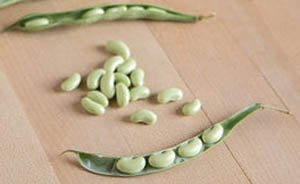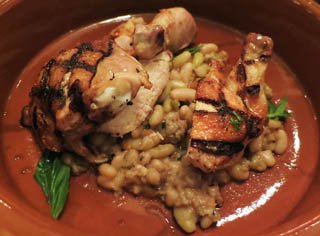Flageolet beans Nutrition facts
Flageolet beans are a variety of haricot beans originally developed in France in the 18th century. The beans, known as flageolet vert or green flageolet, were first identified by a French grower named 'Chervier' near the Paris suburb.
Flageolet is unique by its smaller than any other kidney beans and of an attractive mint-green color, a rare trait among bean germplasms. Fresh green seeds are obtained from harvesting well-filled pods but just short of maturity.
Botanical name: Phaseolus vulgaris L. (Flageolet Group). Family: Fabaceae, and the genus: Vigna. Common names: Green flageolets, Haricot flageolet à grain vert (French), and Verdina or Faba do Marisco (Spanish).
 |
| Semi-dried flageolet beans. |
Flageolet bean is an annual, small vine-type (pole-type) bean plant that needs some trellising to support its growth. It flourishes in well-draining sandy soil with adequate humus and moisture.
Flageolet is a short-duration crop, that takes 50-90 days from seedling to harvest depending on whether the seeds are harvested fresh or dried. Pods are straight, cylindrical, and hold about 6-7 seeds.
Flageolet beans are "green shelling beans" similar to the Italian Borlotti and Cannellini beans. To obtain semi-dried seeds, the whole plant was pulled up, hung upside down, and allowed to dry under the shade.
Health benefits of Flageolet beans
Flageolet beans are wholesome nutritious foods. 100 grams of flageolet beans carry 346 calories, and 19.1 g or 34% of recommended daily allowance of protein.
Flageolet beans are fiber and protein-rich, low-fat and cholesterol-free food. Dietary fiber works as a bulk laxative that binds to cancer-causing chemicals in the colon and helps in the quick elimination of these toxic substances from the gut thus protecting colon mucosa from cancers.
Dietary fiber helps in reducing blood LDL cholesterol levels by blocking the reabsorption of cholesterol-binding bile acids in the colon.
Raw green and semi-dried flageolet does not require presoaking or precooking and would be easily digested because at that stage it has not developed many of the anti-nutrients that normally make other dry kidney beans difficult to digest.
Flageolet skin being thinner than in other Phaseolus vulgaris cultivars also facilitates digestion.
Flageolet beans do not contain gluten. For the same reason, they preferred protein-rich, gluten-free food alternatives in gluten-allergy and celiac disease patients.
The beans are one of the finest sources of many B-complex vitamins like folates, pyridoxine, thiamin (vitamin B-1), pantothenic acid, riboflavin, and niacin. Most of these vitamins work as co-factors for the enzymes in carbohydrate, protein, and fat metabolism.
Dry Flageolet beans hold 121 μg of folates (30% of DV). Folate, along with vitamin B-12, is one of the essential co-factor for DNA synthesis and cell division. Adequate folate in the diet around conception and during pregnancy may help prevent neural tube defects in newborn babies.
Furthermore, they are incredible sources of several essential minerals. 100 g of flageolets hold selenium-90%, copper-75%, iron-91%, manganese-69%, phosphorus-63% and zinc-23%.
100 g of beans hold 1185 mg or 25% potassium. It is an essential electrolyte of cells and body fluids that helps to counter the pressing effects of sodium on heart and blood pressure.
The U.S. Dietary Guidelines for Americans recommends eating about 3 cups of legumes, including beans, per week. To meet the weekly Dietary Guidelines for legumes, you need to eat half a cup of beans every day.
| Principle | Nutrient Value | Percent of RDA |
|---|---|---|
| Energy | 346 Kcal | 17% |
| Carbohydrates | 42.1 g | 32.5% |
| Protein | 19.1 g | 34% |
| Total Fat | 2.60 g | 12% |
| Cholesterol | 0 mg | 0% |
| Dietary Fiber | 23.4 g | 61.5% |
| Vitamins | ||
| Folates | 121 μg | 30% |
| Niacin | 1.93 mg | 12% |
| Pantothenic acid | 0.68 mg | 13.5% |
| Pyridoxine | 0.41 mg | 31.5% |
| Riboflavin | 0.03 mg | 2.1% |
| Thiamin | 0.31 mg | 26% |
| Vitamin-C | <0.5 mg | <1% | Electrolytes |
| Sodium | 7.9 mg | 0.5% |
| Potassium | 1185 mg | 25% |
| Minerals | ||
| Copper | 0.68 μg | 75.5% |
| Iron | 7.3 mg | 91% |
| Magnesium | 160 mg | 40% |
| Manganese | 1.6 mg | 69.5% |
| Phosphorus | 0.440 mg | 63% |
| Selenium | 50 μg | 90% |
| Zinc | 2.3 mg | 21% |
| Phyto-nutrients | ||
| β-carotene | 27 μg |
Selection and storage
Beginning from September till November, fresh green flageolets are readily available in most farmers' markets and groceries in France and Spain. In the US and Canada, semi-dried, dried as well and canned flageolet beans in water are available online and in supermarkets.
Choose fresh, pale-green, smooth beans in packets from authentic sources for ready-to-cook purposes. Semi-dried beans also work well in recipes but need a little longer cooking.
Avoid beans with broken, surface cracks, or cuts as they do not stand well once boiled.
Store them in a cool, dark place, in an air-seal plastic/metallic bin away from high temperatures and humidity.
Preparation and serving methods
The beans are one of the most sought-after in North America and Europe for their wholesome nutritional properties. Boiled Flageolet has a fine, buttery texture and a pleasant beany taste; reminiscent of green soybean (edamame) or lima bean.
Flageolet bean is characterized by having a pale green color with thin skin and tender pulp. Once cooked, it has a pleasant texture and unique beany flavor.
Dry beans often require soaking in cold water for 3-5 hours. They cook more easily than any other haricot varieties. Soaking and boiling also removes anti-nutritional compounds and reduces flatulence.
Here are some serving tips:
 |
| Yogurt Marinated Kilgus Farm Poussin-Flageolet Beans, Tuscan Soffrito, Basil. Photo courtesy: Lou Stejskal |
Flageolet beans go well in traditional dishes like cassoulet with lamb (leg), ham, and other fatty meats or meats with a strong taste (bacon).
Boiled beans are then mashed to employ in dips; or pureed and seasoned with garlic and thyme, as an accompaniment for fish and prawns.
Flageolet beans are used in soups, as pot beans, and stews mixed with other complementing herbs, spices, and vegetables.
Just like other white haricot, cooked flageolets can also be used as a base for salads, with various finely chopped vegetables, such as celery, cucumbers, onions, and green, red, or yellow bell peppers.
Safety profile
Consumption of raw, and soaked flageolet beans is not advisable and harmful for health. It can cause phyto-hemagglutinin (lectin) toxin poisoning, a condition that may cause clumping of red blood cells in humans. Other symptoms include nausea, vomiting, and diarrhea. Cooking in a pressure cooker eliminates the toxins and makes them safe. (Medical disclaimer).
Also read ≻≻-
Adzuki beans nutrition facts and health benefits.
Chickpeas nutrition facts and health benefits.
Lima beans nutrition facts and health benefits.
fava beans nutrition facts and health benefits.
≻≻-Back to Legumes from Flageolet beans nutrition. Visit here for an impressive list of vegetables with complete illustrations of their nutrition facts and health benefits.
≻≻-Back to Home page.
Further Resources: